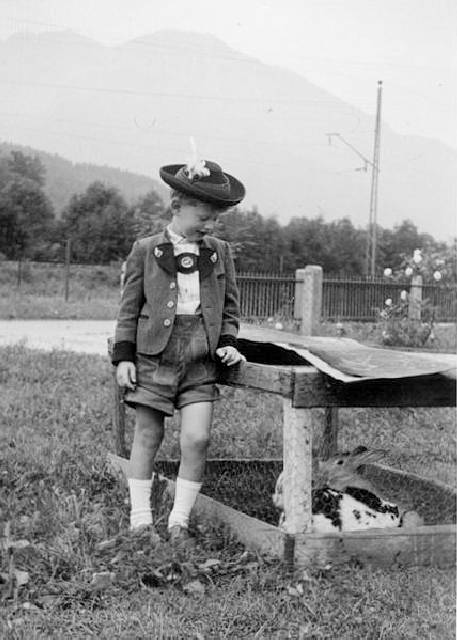
Figure 1.--Here we see a German boy wearing Bvatian folk coistume, probably in the 1950s. The montaneous background suggests that he may well have been Bavarin. I thought the hat he was wearing was for girls, but apparently boys als0 wore them. |

|
We note both boys and girls wearing German ethnic costumes. Some of the best known German ethnic costumes are lederhosen, both short pants and knicker style. These ethnic costumes are called "tracht". Lederhosen are commonly worn by German bands and dance groups. Boys participating in German ethnic events commonly dress up in lederhosen. HBC has noted consideable variation in folk costume. Women and girls also wear a variety of ethnic outfits. There are many regional differences. One example is Allg�uer style. The woman's Festtracht exemplifies the traditional simplicity of the area. We wear: a gray skirt (about 16 rows of gathering---the way this skirt is gathered typifies the Allg�uer style) , a white Trachten blouse, a black Mieder, a Allg�uer Hat with feather (worn on the crown of the head) , a red apron, a single red flower Trachten Shoes (white or black hose).
Some of the best known German ethnic costumes are lederhosen, both short pants and knicker style. These ethnic costumes are called "tracht". Tracht is folk dress based on the actual clothing worn in rural areas during the early 19th century. Germany at the gime was just beginning to industrialize. The rapidly growing cities drew workers from the countryside. Sucessful people with rural origins were by the late-19th century ;ppling on their rural roots with nostagia. Lederhosen are commonly worn by German bands and dance groups. Boys participating in German ethnic events commonly dress up in lederhosen. HBC has noted consideable variation in folk costume. Many of these variations may be just variation of the costumes worn in Germany. Some of these differences may be regionally based. The outfits included different types of hats, blazers, shirts, pants, and socks. I'm not sure what the hat style was called but feathers or Gamsbarts (beards of a chamois) were often added. One style is the Allg�uer Hat with Gamsbart. For festive occasions--a single flower in hat is added to match the womens' hats. The blazers were often grey with a wide variety of trim--often in green. Trachten shirts often have their sleeves rolled up. The pants were either Lederhosen or knickers style pants. Some were elaborately trimmed. Hosentr�ger is one distinctive regional style. It may have gereen embrodiery with large white Edelweiss. Boys wore both kneesocks and a kind of hose that was a band around the calf. The kneesocks are most commonly gray with double green stripes. I'm not sure why this type of kneesock is so common. Trachten shoes are also worn. A German reader tells HBC that until about 1920 or so, the boys, who took care of cattle in the Black Forest, wore a mantle of straw over the clothes, which they usually
got from their employer.
German women and girls also wear a variety of ethnic outfits. The principal item is the Dirndl. The Dirndl is a type of dress once commonly worn throughout Bavaria and Austria. It is now worn for special occassiions.
The proper of the dress is Dirndlkleid. The origins of the term is that 'Dirndl' in Alpine regions is a diminutive for 'woman'. It is still occasional heard although now increasingly obsolete. It was originally a peasant or country dress as opposed to the more refined, fashionable dress iof the cuities. And becaise maids were recruited from the peasantry, it also became seen as a maid's dress. Germany began to change as after the Napoleonic Wars
and the Industrial Revolution took hoild (mid-19th century). Many Germans who had moved to the city began to become nostalgic about their rural roots. Well-to-do urban Germans started adopting the Dirndl as holiday wear in the countryside. Ant they began to have their children photographed in folk outfits. The girls wore Dirndles and the voys Lederhosen and other Tracht gaerments. These garments by the turn-of-the 20 century had become a kind of emblem of German heritage. There were a wide variety of Dirndles with variatiions often regionally based. Thgere were, however, some common elements. The bodice of a classic Dirndl is typically low-cut with a squared neckline. They were not as revealing as modern examples, but certainly more revailing than other 19th century garments. The blouse-like bodice is commonly tight and either sleeveless or short, baloon sleeves. The skirt part of the Drindl is both long and full. The short modern Drindl sometimes seen today are not authentic. The skirt flares out from the tight bodice--a dramatic characteistic of the Dindl. An apron is often added to stress the rural peasant origins.
here are many regional differences. One example is Allg�uer style. The woman's Festtracht exemplifies the traditional simplicity of the area. We wear: a gray skirt (about 16 rows of gathering---the way this skirt is gathered typifies the Allg�uer style) , a white Trachten blouse, a black Mieder, a Allg�uer Hat with feather (worn on the crown of the head) , a red apron, a single red flower Trachten Shoes (white or black hose).
Navigate the Boys' Historical Clothing Web Site:
[Return to the Main German ethnic costume page]
[Return to the Main German ethnic page]
[Return to the Main German page]
[Return to the Main lederhosen page]
[Introduction]
[Activities]
[Biographies]
[Chronology]
[Clothing styles]
[Countries]
[Essays]
[Bibliographies]
[Contributions]
[FAQs]
[German glossary]
[Images]
[Links]
[Registration]
[Tools]
[Boys' Clothing Home]
Navigate the Boys' Historical Clothing ethnic pages:
[Main ethnic page]
[German]
[Greek]
[Irish]
[Native American]
[Scottish]
